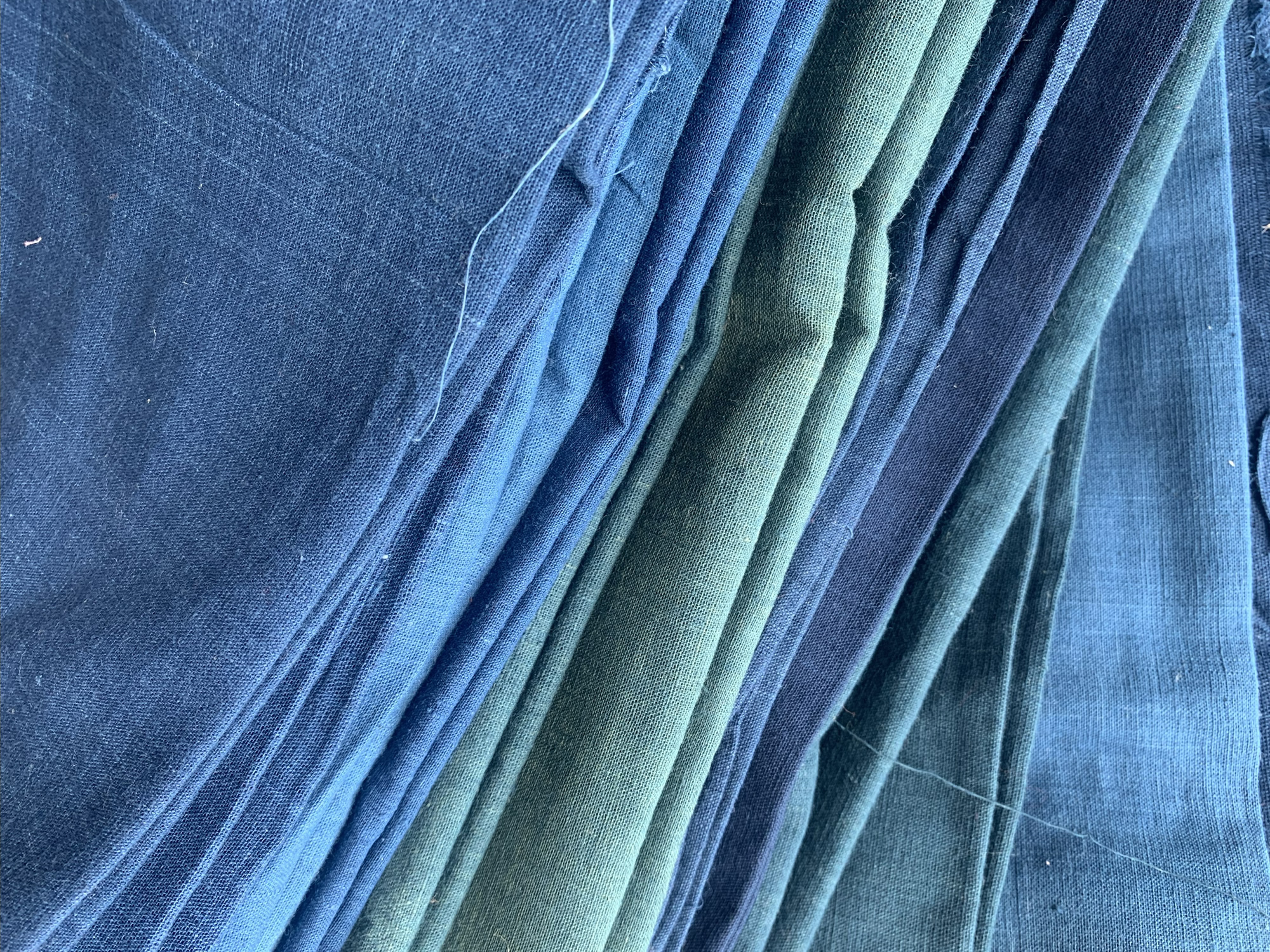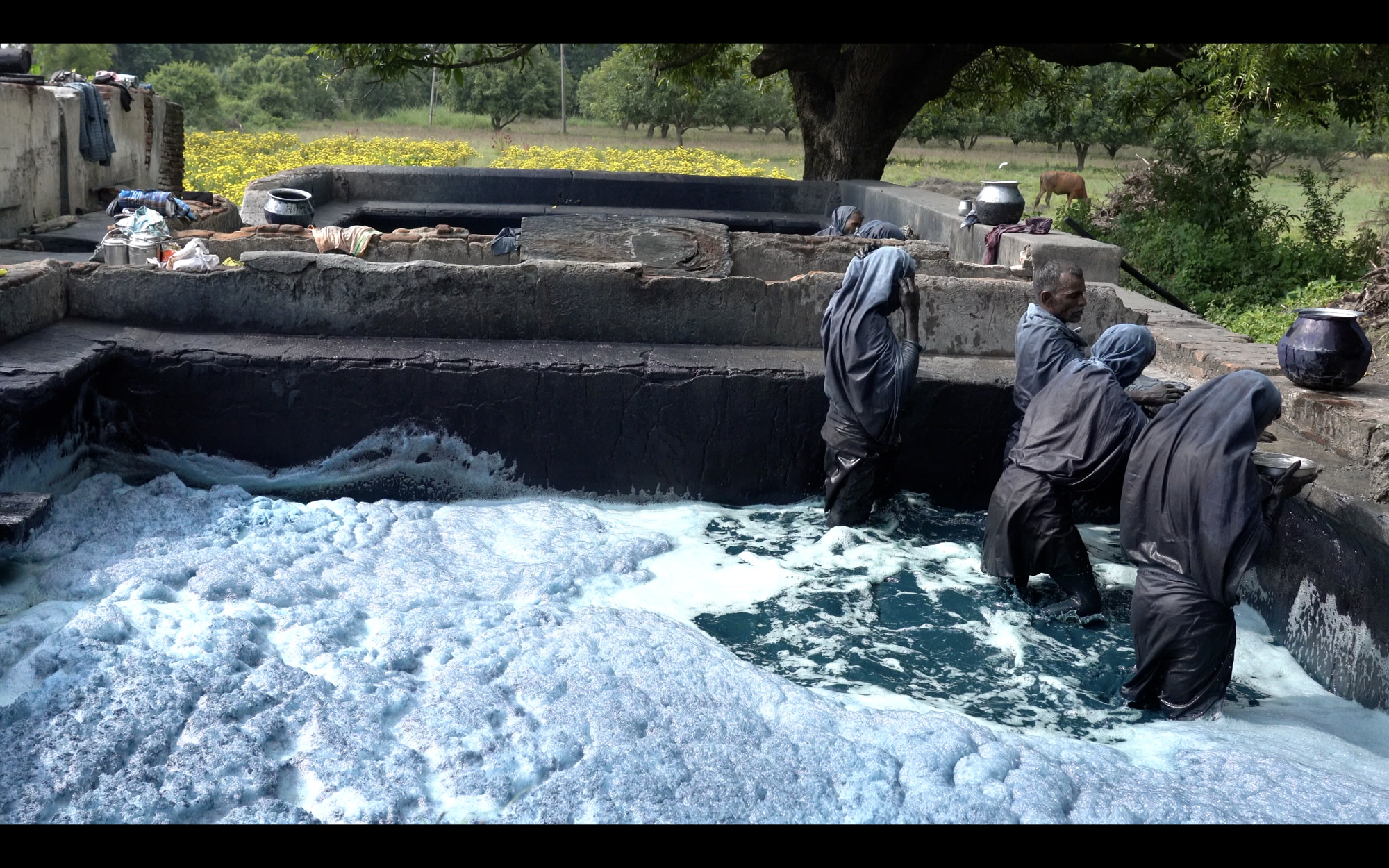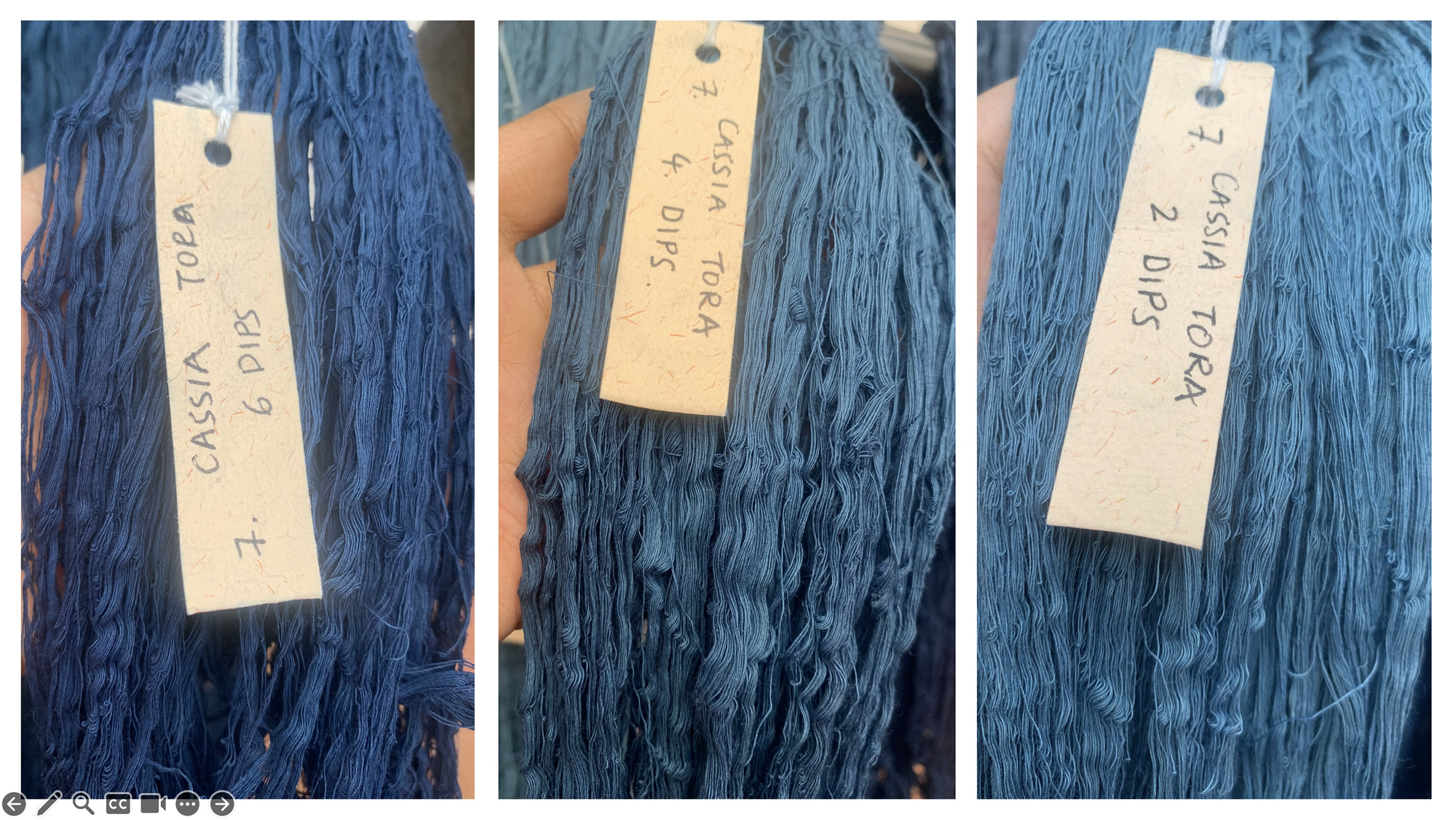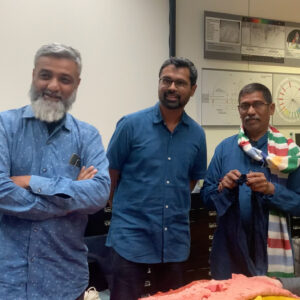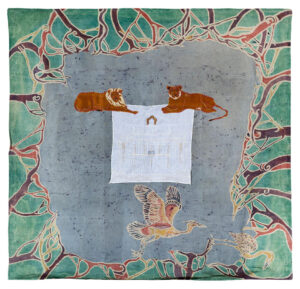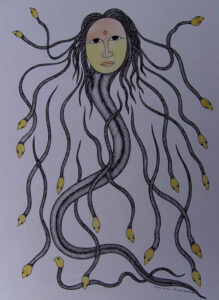“Fiber art sounds like it has gone and died in the museum – our textiles are made of living fibers!” retorted master Bandhini tie-dye artist Abdulaziz Alimamad Khatri from Bhadli, Kachchh and master indigo dyer-weaver Odelu Vurugonda from Chennur, Telangana when they were asked to describe their natural dyed textiles in “art-speak”. This sentiment is borne out of the artisans’ long collective encounters with institutions from the art world. A number of Abdulaziz’s Bandhini creations are displayed at prestigious institutions such as the Victoria and Albert museum that he rues are difficult to access for his fellow artisans in Kachchh and hence are of limited use in furthering his craft tradition. Decades of tending to fermented vats of indigo, informs Odelu’s approach to colour as a phenomenon that is not only fixed to cloth, but makes the fiber come alive.
Instead of art terminology, the craft community prefers to use technical language to talk about their practice. For instance “mordanting” is a process in natural dyeing that bonds the dye and fiber molecule together, without which the colour fades with each wash. Some of the earliest examples of Indian cotton textiles, from Fustat, Egypt near Cairo still retain their blue and red colours, attesting to the endurance of natural dyeing and printing techniques. While the mordant is a biochemical substance (such as tannins for cotton fibers), mordanting is also understood by artisans as the art of creating a life-long bond. Indigo occupies a special place among dyes for cotton fibers, because it doesn’t need a mordant — the fermentation of the dye infuses the fiber molecules with life through microbial action. Each time the fibers are dipped into the vat, the indigo colour-bond deepens and strengthens. Life and time act as the mordant for indigo
Although the language of biochemistry allows us to describe some aspects of indigo dyeing, chemical formulae fail to represent the sensorial delight that is experienced by the intermingling of microorganisms between the dye, textile and body. In the vat fermentation process of dyeing indigo, colour is perceived through smell, taste and touch, before it is confirmed by the eye. As the indigo dyer stirs the vat and lets the liquid slip through their fingers, they smell and taste the dye bath, feel the firmness of the foam and watch for the green that glints through the droplets to assess the level of fermentation. When the vat is ripe, cotton yarn or cloth is dipped in to absorb the dye bath. Green oxidizes into indigo hues as the soaked fibers that emerge from the vat are wrung and unfurled! Similar biochemical reactions are observed in the process of extracting the indigo dyestuff from the plant. The unassuming looking indigo shrubs are soaked overnight. The strained water is aerated through a process of rhythmic kicking and beating which gradually oxidizes and turns the green liquid into a pool of indigo. To witness this alchemical transformation of colour in the indigo dyemaking and dyeing process is to be blessed by nature herself.
In India alone, at least sixty species of Indigo (Indigofera) have been documented, including Indigofera Arrecta, West Bengal; Indigofera Suffruticosa, North Eastern states; Indigofera Himalayensi and Indigofera Longiracemosa in Southern states. Instead of understanding and preserving this diversity, colonial interests preferred a monoculture of Indigofera Tinctoria since it contained a higher concentration of the colour pigment. The forced colonial plantation of indigo in the Champaran district became fertile ground for Mahatma Gandhi’s first successful nonviolent civil disobedience movement in 1917. To compete with British colonial industry, synthetic indigo dye was invented in 1883 by German chemist Adolf von Baeyer that was not only a poor imitation of the original colour, it was toxic to dyer, wearer and environment. The capitalist proliferation of synthetic indigo eroded craft networks of fermentation dyeing processes and by the 1990s, only a handful of Nilgars (master-indigo dyers) especially Katubadi Yellappa from Uravakonda, Andhra Pradesh kept the generational knowledge practice and vats alive.
Fortunately, craft researchers Uzramma and Jagada Rajappa along with renowned dye chemist K V Chandramouli conducted training sessions and workshops to teach natural dyeing processes to contemporary artisanal communities. To correct the misapprehension that natural dyes quickly faded away, Uzramma opened her potli (bundle) of old textiles, that she had inherited and collected, as proof that textiles could retain colour even after a hundred years. Uzramma also taught herself to read colonial archives against the grain to understand the roots of historical ruptures and found distortions of natural dye recipes in monographs written by colonial civil servants. Jagada worked with Kalamkari artisanal communities and learnt the use of Myrobalan as a mordant for cotton. The aesthetic memory of pre-colonial naturally dyed handwoven textiles and the generosity of these human-mordants who willingly shared their knowledge with craft communities, gave Uzramma the maverick-like confidence to set up Malkha. Over two decades, Malkha has proved the viability of small scale yarn spinning, natural dyeing and handloom weaving in the marketplace. When Uzramma is asked what she hoped to achieve – Securing the livelihood of artisans? Reviving endangered cultural heritage? Putting Indian craft on a global stage? She puts it simply – a Real Utopia – borrowing Erik Olin Wright’s phrase that enfolds the tension between dream-like fantasy and real-life practice. Perhaps this ability to mordant these binary opposites is what was required to bring indigo back to the future.
Two master indigo dyers emerged from these efforts – Mohd. Salim Pasha and Odelu Vurugonda. As Uzramma’s driver, Salim had the opportunity to attend all workshops of natural dyeing. Soon he managed the Neeli Dye House at the National Institute of Rural Development (NIRD), Hyderabad and seeded a palette of natural dyes for Malkha. Salim was a man of few words – he preferred to express his knowledge through shade cards that he made from yarn samples that he dyed. Once when he had a cold he was asked how he could tell if the indigo vat was ripe without smelling it – he wryly pointed to the flies hovering about the vat – as a reminder that the entire ecosystem informs the dyer’s sensorium. Another time, Salim was shown a filmed interview with a dyer from Kachchh who spoke eloquently about how he fought caste oppression and became a successful craft entrepreneur. Salim ignored the verbal eloquence and focused on the dyer’s performance. He asked the filmmaker, Gauri Nori, a series of questions – What did the vat smell like? How firm did the foam feel? What was the temperature of the dye bath? What was the pH value of vat? When Gauri had no answers Salim declared the film was of little use because it offered no tangible information about the indigo dyeing process. It became clear to everyone that indigo could not be documented in words, photos or film. It can only be experienced as performance between the dyer and vat.
Odelu introduces himself as being born in the crossing of the warp and weft – having inherited the collective knowledge of many generations of weavers. With Uzramma’s support, Odelu and fellow weavers pulled the Chennur Handloom Cooperative Society out of crippling debt. Odelu recounts his experience of learning to dye with indigo from Yellappa in the 1990s in mythical proportions – like being under Dhonacharya’s tutelage. Yellappa had long given up hope of finding students with the right aptitude for learning this complex knowledge. Yellappa would consider each vat to be a child with a distinct personality – it was the dyer’s responsibility to raise them right till maturity. Odelu took on the challenge of keeping the indigo vat alive for many years till Yellappa’s next return to Chennur thus putting an end to his guru’s despair. While Salim proved the ability to standardise the extraction of and dyeing with natural colours, Odelu highlights the many technical possibilities that arise out of handloom weaving of naturally dyed yarn. Given that most weavers today would find it difficult to use naturally dyed yarn, Odelu has gone on to reconstruct complex patterns from ancient textiles on 12 pedal looms and tie -dyed singles yarn ikat. Odelu continues his gurus’ legacy of generously sharing his knowledge with everyone who is interested, including his latest protégé from the weaving village of Thangallapalli, Mamidala Bhumaiah who used to be a cook and now dyes complex ikat patterns. Not satisfied with merely mastering the use of Cassia Tora seeds for fermenting the indigo vat, Odelu is currently experimenting with different types of reduction agents, including tamarind, jaggery, henna, dates, madder, and banana, that are used by indigo dyers from other parts of the world. As a knowledgeable practitioner, Odelu was invited by the faculty of Chemistry at Technische Universität Dresden, the birthplace of synthetic dyes, for a conference on the Craft Origins of Colour and its Orderings in 2024. On visiting the university’s Historical Dye Collections, Odelu astounded the German archivists with his ability to tell quality simply by holding and smelling the centuries old indigo cakes.
The ownership of knowledge that arises out of these embodied ritual-practices could also offer an alternative mode of craft-speak or tareeka to grapple with the existential questions that arise in the age of generative AI. This article proposes these handloom tareekas to understand the value of the handmade to our collective creative futures. In terms of the practical knowledge of indigo dyeing, Odelu is recognised as a master by state authorities and fellow master craftspeople. But for Odelu, the craft of dyeing and weaving by hand with natural materials is also a spiritual quest. If we ask him to describe what kind of spiritual quest, he sings a refrain from a Telugu bhajan he learnt from his grandfather,
బట్టకి రంగులు ఉన్నవి గాని పత్తికి రంగులో ఉన్నావా
పత్తి వంటిదే పరమాత్మ బట్ట వంటిదే నీ ఆత్మ
నీ ఆత్మ చెంచలమైతే పరమాత్మ చెంచలమౌను
నీ ఆత్మ నిచ్చలమైతే పరమాత్మ నిశ్చలమౌను
Cloth is dyed many colours, yet seek the colour of cotton
Kora is the divine, while your soul is the multi-coloured cloth
If your soul is restless, then the divine soul is restless
If your soul attains stillness, the divine soul will be still

